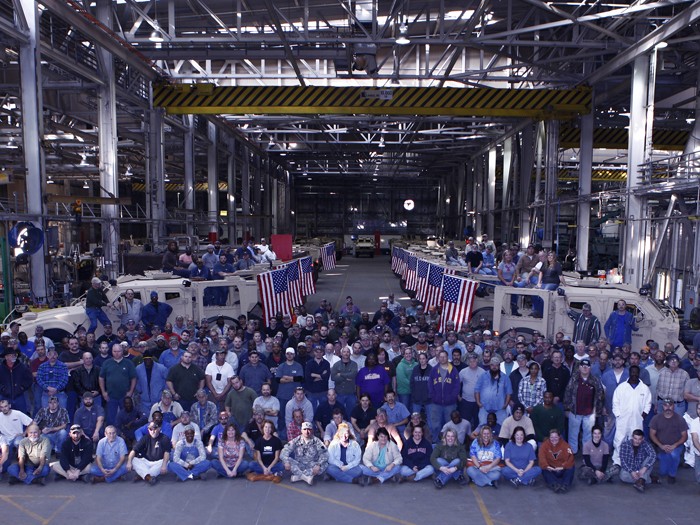Award Winning Program
Achievement Marches Forward

The guiding philosophy of the Red River Army Depot team is that soldiers’ lives depend on the quality of their work, and workers’ lives depend on how safely they achieve that quality.
Red River Army Depot, recipient of the Teddy Award in 2007 and again in 2012 in the federal category, continues its outstanding efforts in minimizing workplace injuries and emphasizing safety – both on and off the job.
Red River, which employs more than 5,400 workers, including more than 2,500 civilians, is a military installation in Texarkana, Texas that repairs and rebuilds tactical combat vehicles and equipment. Due to the success of its workers’ compensation and safety programs, the depot since 2007 has consecutively achieved the lowest lost-time rate within the Army’s major industrial installations.
In 2007, the depot established “Role Model” standard operating procedures that streamline the entire workers’ compensation process, resulting in a significantly faster return to work. To date, RRAD continues to achieve decreases in costs and lost-time days, as well as number of claims filed.
Since the implementation of the procedures in 2007, the depot has returned 68 injured employees to work, with a cost avoidance of more than $55 million, decreased lost-time cases by 68 percent, decreased lost-time case rate by 47 percent, decreased the number of lost-time days by 90 percent, decreased the number of claims filed by 55 percent and decreased claims costs by $1 million.
A Model for Others
Moreover, Red River is recognized throughout the Army for having established the “prototype” processes and procedures that have facilitated the success of its return-to-work program. The depot has shared best practices throughout the Army, and continues to mentor several other installations including Anniston Army Depot; Pine Bluff Arsenal; McAlester Army Depot, Memphis, Ft. Polk, Ft. Hood and others.
“The key to success is great communication. We care about the workforce and are diligent in those activities — not only when an employee gets hurt, but we’re also trying to prevent accidents in the first place.” — Brent Jones, safety officer, Red River Army Depot
Ann Harmon, injury compensation program administrator, said she particularly loves the fact that the depot has implemented an accident review board, in which injured workers and their supervisors can communicate their opinions on how the team can better the process.
“To me, it really gets the buy-in of employees and makes them feel like they are an integral part of the depot,” Harmon said. “Our number one priority is making each one of our injured workers feel special, getting them recovered and back to employment.”
The accident review board, chaired by the depot’s commander, reviews accidents to learn what employees think needs to be done to prevent such accidents from occurring in the future, and enhances management’s ability to make sure corrective actions have taken place or are in the process of taking place, said Brent Jones, safety officer.
In the discussions, employees, management and union representatives are all “sitting across the table, eye to eye, no one looking down their nose at anyone else,” Jones said. “It’s truly an open forum for sharing information.”
“The key to success is great communication,” he said. “We care about the workforce and are diligent in those activities — not only when an employee gets hurt, but we’re also trying to prevent accidents in the first place.”
Red River has also received numerous awards from the Army, including an “all GREEN” audit rating in 2012 by an Army Materiel Command (AMC) inspectors’ general team, and recognition for having the best workers’ comp program within the AMC, based on program effectiveness, proactive case management, and creation of new and improved processes using the principles of Lean Six Sigma. In March, Red River invited OSHA to audit its safety program, which resulted in OSHA recommending the installation for the agency’s Voluntary Protection Program Star status, recognizing the depot for maintaining injury and illness rates below the national average for similar installations.
A great deal of the success of Red River’s workers’ comp and safety programs can be attributed to Harmon, said chief of staff Theresa Weaver. Harmon works “so diligently” to coordinate with the depot’s safety officer, director of emergency services, the hygiene offices and legal offices, to quickly identify and resolve any workers’ comp claim disputes.
The team also keeps communication with the local medical community “fresh,” by making sure that new physicians and staff who come to the area know of the depot’s workers’ comp and safety programs, and that the team is willing to accommodate any type of injury and work situation, Weaver said.
“Lastly, we care about our employees’ safety after they leave work,” she said. “One of our employees recently had a terrible car accident, and we just want our employees to take safety very seriously, so they don’t have to pay the ultimate price.”










